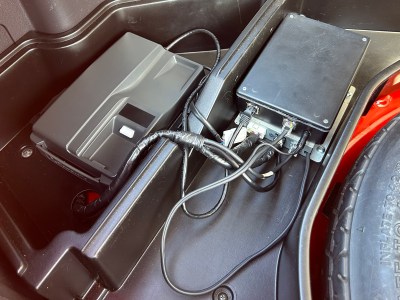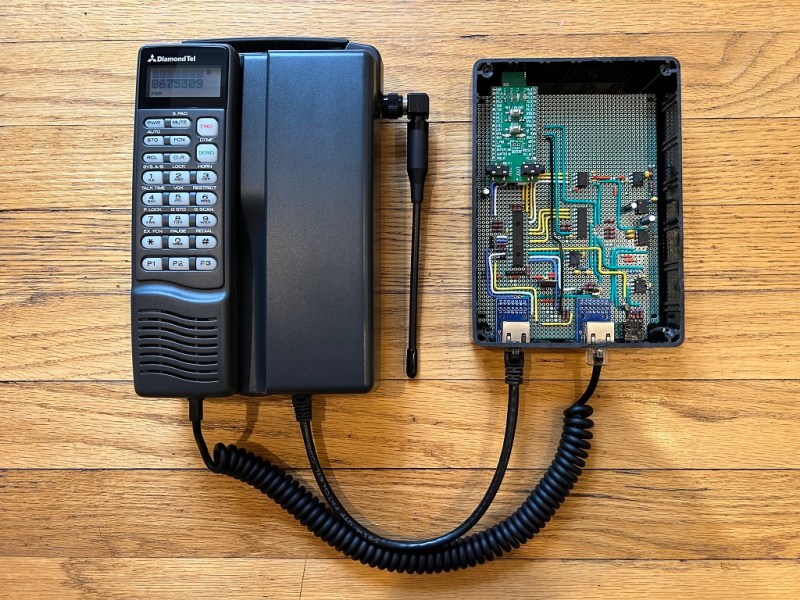[Jeff Lau]’s Mitsubishi 3000GT comes with all the essential features you’d expect in a fancy sports car from 1993: pop-up headlights, movable spoilers, and a fully-functional telephone handset in the center console. The phone was fully functional until North America’s first-generation AMPS cellular network was shut down back in 2008, since then, it hasn’t done much but show “NO SVC” on the display. That is, until [Jeff] decided to build a Bluetooth adapter that lets it connect to a modern smartphone.
The easy solution would have been to simply connect the handset’s speaker and microphone to a standard Bluetooth headset, but that would have destroyed the 1990s aesthetic it had going on. So what [Jeff] did instead was construct a plug-in module that hooks up to the phone’s base station in the trunk and communicates directly with all the existing systems. That way, the phone works in exactly the same way it always did: the radio is automatically muted during calls, the buttons on the steering column work as expected, and you can even dial and store numbers using the buttons on the handset.

It took a lot of reverse-engineering to figure out the technical details of the DiamondTel Model 92 that came with the car as a factory option. [Jeff] helpfully documented all of his findings on the project’s GitHub page, making it easy for anyone with a similar system to implement their own upgrades. The main components of the upgrade kit are a BM62 Bluetooth module that connects to a modern phone, a PIC18F27Q43 microcontroller to implement the car phone’s interface and menus, and several analog chips to process the audio. All of these are mounted on a piece of prototype board and housed in a standard plastic enclosure that neatly fits on top of the existing equipment in the trunk.
While the hardware mod is a pretty neat job already, the real strength of this project is in the software. [Jeff] worked hard to implement all relevant features and mimic the original interface as much as possible, even using 1G phone test equipment to simulate incoming calls from the long-gone network. He also added menu features to enable Bluetooth pairing, use voice assistants, and even play games including versions of Snake and Tetris stripped down to match the handset display’s constraints.
As classic phone conversions go, this is definitely one of the most impressive. [Jeff]’s extensive documentation should come in handy if you’ve got a similar model, but if you don’t, there’s still plenty of ways to connect modern electronics without defacing your classic ride’s interior.















Nice protoboard layout !
Now this is a hack! Congrats
That is epic.
That is what I call a great hack. Why throw away the good stuff when it can be revived. Awesome job!
In some ways, it was actually easier to keep the original components and let them take care of many details for me. All the hands-free integration just works as originally intended, and I didn’t have to worry about building audio amplifier circuitry to drive the car speaker. There’s also built-in noise reduction intended to cut out road noise specifically already.
I’m even relying on the original transceiver’s power on/off behavior to to turn on/off with the ignition. My circuit simply receives ~12V power whenever the transceiver turns on. The handset’s power button basically passes through my circuit to the transceiver so that it works as originally intended as well (I do monitor the power button for some purposes, but my circuit has no ability to control power on/off itself at all).
I’m very pleased with how I’ve been able to leverage all of the original technology as-is, and only interface with it instead of modify it.
I think you explore selling such kits. May even be that it works with other cars of that era, perhaps with some modification.
I’m still making progress toward a version of this project that I could reasonably sell, but it will not be compatible with any other brands/models of car phone because it depends on a direct connection with the handset. There is no standard for car phone handset wiring connections and communication protocols. Each brand, and even different models from the same brand, can have differences in what each wire is used for, how digital communication works, etc.
Here’s a demo of the latest version of this project: https://www.youtube.com/watch?v=uEtvmijlxUE
Hi Jeff,
I have just purchased a 1989 Porsche 928 which has a disconnected 4800X phone still installed but cable from phone to car electrics has been cut. There are 8 wires (2 x shielded, yellow, red, black, brown, red/white and orange) which wires connect to vehicle ground and +ve supply just so I can get the phone display and buttons to light up? I’ve searched for a wiring diagram but can’t find anything so far and don’t want to fry anything through trial and error. Hope you can point me in right direction. Cheers, Nigel.
If it is like nearly every other car phone of the era, then that 8-wire cable is a connection between the handset and the transceiver, and does not connect directly to vehicle power/ground. It will be a proprietary connection for that brand/model of phone (i.e., different from what I reverse-engineered for my car phone’s wiring). And the handset likely doesn’t do much on its own without being commanded by the transceiver to do things. So even if you identify which wires are power and ground for the handset, and what voltage it takes, the handset probably won’t do anything noticeable upon supplying power.
I think your best bet is to hope the transceiver is still in the car somewhere so you can repair the connection between the handset and transceiver, and then figure out how to power the transceiver.
Gorgeous breadboard work. That’s what I WANT mine to look like
Cutting all those wires to length and bending them was so tedious… but so worth it. I’m not embarassed to show this prototype, unlike my previous super sloppy solderless breadboard prototype that was completely unplanned.
I keep calling you ask you about your project but this woman named Jenny keeps answering…..
Absolutely nailed this project. The integration and the fine level of details is superb. Plus, you have a car on my bucket list. It would make a great garage mate to my ’91 300ZX twin turbo.
Thanks!
The phone number displayed on startup is programmable, using a similar programming mode on the handset that was used on the original phone to setup the cell service carrier settings. I even support configuring dual numbers like the original phone did, and the same method for switching between numbers as the original phone. This allows me to have my real number programmed, but also quickly switch to the fake Jenny number if I want to record a video or show it off without revealing my real number :)
I agree, the 3000GT and 300ZX would make a great pair. Both have engine bays that are packed completely full :)
Right?? Need to change the oil? Pull the engine! But that phone brings back memories as when they came out I was a bench tech for a 2 way radio shop and I can’t even remember how many of them I installed in everything from limo’s to police and fire equipment to 18 wheelers.
You got a new subscriber for this one. Very nice job Jeff.
That prototype board layout alone is a work of art.
Making the adapter box is the far more sane option.
A fun alternative would have been making something like this:
https://hackaday.com/2011/03/31/building-an-advanced-mobile-phone-service-amps-base-station/
And connecting the phone to that with a suitably beefy attenuator.
And then adding in the bluetooth and all that stuff, on the basestation end.
My original plan was to build a Bluetooth adapter that connected to the antenna port (coax connector) on the transceiver and interface with the transceiver like an AMPS base station… but with a direct wired connection. However, I couldn’t find components and information about how to easily deal with the 800 MHz FM signals, Manchester encoding, and all the audio processing necessary. I’m actually glad I couldn’t figure that out, because I’m much happier with the end result of my current approach.
With an AMPS simulator approach, the car phone would be limited to only exactly what its original behavior was, and my custom interfacing with the car phone would be limited to what is supported by AMPS. There would be many awkward situations that I couldn’t handle well.
Example: What if you power up the car phone and it reconnects to your cell phone in the middle of a call? With my current approach, the call audio seamlessly transfers over to the car phone. With the AMPS simulation approach, I would have to simulate an incoming call to the car phone, the car phone would ring, and you’d have to answer it to continue the call.
The AMPS simulation would also require all Bluetooth connection management UI to be part of the adapter in the trunk, rather than directly accessible on the handset.
And of course, I wouldn’t have been able to add games and custom ringtones :)
But an AMPS simulator Bluetooth adapter would definitely be cool, because it would be compatible with ANY old analog car phone with a coax antenna connector.
Jeff did it the right way here.
Any chance you can build one for me? I have a 1999 Mercedes S500.
I’m not building any for sale. And it probably wouldn’t work for your car phone anyway, because I’m directly interfacing with the handset and transceiver of a specific Mitsubishi-manufactured phone model.
All the technical details, diagrams, source code, etc., are freely available for personal use to build your own: https://github.com/UselessPickles/diamondtel-m92-bluetooth